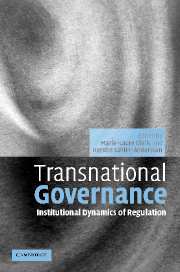Book contents
- Frontmatter
- Contents
- List of figures
- List of tables
- List of contributors
- Acknowledgments
- List of acronyms
- 1 Introduction: A world of governance: The rise of transnational regulation
- I Institutional forces
- II A dynamic transnational topography
- III Transnational governance in the making
- 12 Dynamics of soft regulations
- 13 Contested rules and shifting boundaries: International standard-setting in accounting
- 14 The international competition network: Moving towards transnational governance
- 15 The emergence of a European regulatory field of management education
- 16 Market creation and transnational rule-making: The case of CO2 emissions trading
- 17 Transnational NGO certification programs as new regulatory forms: Lessons from the forestry sector
- 18 Institutional dynamics in a re-ordering world
- References
- Index
17 - Transnational NGO certification programs as new regulatory forms: Lessons from the forestry sector
Published online by Cambridge University Press: 22 September 2009
- Frontmatter
- Contents
- List of figures
- List of tables
- List of contributors
- Acknowledgments
- List of acronyms
- 1 Introduction: A world of governance: The rise of transnational regulation
- I Institutional forces
- II A dynamic transnational topography
- III Transnational governance in the making
- 12 Dynamics of soft regulations
- 13 Contested rules and shifting boundaries: International standard-setting in accounting
- 14 The international competition network: Moving towards transnational governance
- 15 The emergence of a European regulatory field of management education
- 16 Market creation and transnational rule-making: The case of CO2 emissions trading
- 17 Transnational NGO certification programs as new regulatory forms: Lessons from the forestry sector
- 18 Institutional dynamics in a re-ordering world
- References
- Index
Summary
Introduction – An emergent form of rule-making on the international stage
During the 1990s, attempts by non-governmental organizations (NGOs) to introduce new certification and labeling (C&L) programs stood at the center of broader efforts to use market instruments to improve environmental and social well-being in transnational commodity production (see also Engels ch. 16). Recognizing that consumers, activists and governments were suspicious of industry-sponsored codes of conduct that often smacked of “green-washing,” leaders of high-profile firms became far more willing to consider independent certification as the decade progressed (Knight 1995; Wasik 1996; Nash and Ehrenfeld 1996; Murphy and Bendell 1997; Economist 1999). At the same time, a number of environmental and social justice NGOs, conceding that traditional corporate boycott campaigns were often ineffective and alienated potential allies, joined the certification bandwagon in earnest (e.g., Friends of the Earth 1996). By the mid–1990s, a variety of new initiatives emerged to reward companies whose practices accorded with NGO-defined environmental and social criteria. These certification programs appeared in a range of industries, including forest products, textiles, footwear, fisheries, rugs and children's toys (see e.g. Nash and Ehrenfeld 1996; Rothstein 1996; Kruijtbosch 1997; Lynch 1997; Coop America 1999; Bartley 2003).
Although these programs were diverse, they nonetheless shared three major characteristics.
- Type
- Chapter
- Information
- Transnational GovernanceInstitutional Dynamics of Regulation, pp. 349 - 374Publisher: Cambridge University PressPrint publication year: 2006
- 11
- Cited by



